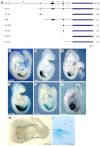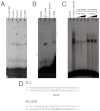Hox genes regulate the onset of Tbx5 expression in the forelimb
- PMID: 22872086
- PMCID: PMC3413163
- DOI: 10.1242/dev.084814
Hox genes regulate the onset of Tbx5 expression in the forelimb
Abstract
Tbx4 and Tbx5 are two closely related T-box genes that encode transcription factors expressed in the prospective hindlimb and forelimb territories, respectively, of all jawed vertebrates. Despite their striking limb type-restricted expression pattern, we have shown that these genes do not participate in the acquisition of limb type-specific morphologies. Instead, Tbx4 and Tbx5 play similar roles in the initiation of hindlimb and forelimb outgrowth, respectively. We hypothesized that different combinations of Hox proteins expressed in different rostral and caudal domains of the lateral plate mesoderm, where limb induction occurs, might be involved in regulating the limb type-restricted expression of Tbx4 and Tbx5 and in the later determination of limb type-specific morphologies. Here, we identify the minimal regulatory element sufficient for the earliest forelimb-restricted expression of the mouse Tbx5 gene and show that this sequence is Hox responsive. Our results support a mechanism in which Hox genes act upstream of Tbx5 to control the axial position of forelimb formation.
Figures






Similar articles
-
A combination of activation and repression by a colinear Hox code controls forelimb-restricted expression of Tbx5 and reveals Hox protein specificity.PLoS Genet. 2014 Mar 20;10(3):e1004245. doi: 10.1371/journal.pgen.1004245. eCollection 2014 Mar. PLoS Genet. 2014. PMID: 24651482 Free PMC article.
-
Regulatory integration of Hox factor activity with T-box factors in limb development.Development. 2018 Mar 22;145(6):dev159830. doi: 10.1242/dev.159830. Development. 2018. PMID: 29490982
-
Tbx5 and Tbx4 are not sufficient to determine limb-specific morphologies but have common roles in initiating limb outgrowth.Dev Cell. 2005 Jan;8(1):75-84. doi: 10.1016/j.devcel.2004.11.013. Dev Cell. 2005. PMID: 15621531
-
Regulation of limb bud initiation and limb-type morphology.Dev Dyn. 2011 May;240(5):1017-27. doi: 10.1002/dvdy.22582. Epub 2011 Feb 28. Dev Dyn. 2011. PMID: 21360788 Review.
-
How the embryo makes a limb: determination, polarity and identity.J Anat. 2015 Oct;227(4):418-30. doi: 10.1111/joa.12361. Epub 2015 Aug 7. J Anat. 2015. PMID: 26249743 Free PMC article. Review.
Cited by
-
Control of mouse limb initiation and antero-posterior patterning by Meis transcription factors.Nat Commun. 2021 May 25;12(1):3086. doi: 10.1038/s41467-021-23373-9. Nat Commun. 2021. PMID: 34035267 Free PMC article.
-
RA Acts in a Coherent Feed-Forward Mechanism with Tbx5 to Control Limb Bud Induction and Initiation.Cell Rep. 2015 Aug 4;12(5):879-91. doi: 10.1016/j.celrep.2015.06.068. Epub 2015 Jul 23. Cell Rep. 2015. PMID: 26212321 Free PMC article.
-
A new scenario of the evolutionary derivation of the mammalian diaphragm from shoulder muscles.J Anat. 2013 May;222(5):504-17. doi: 10.1111/joa.12037. Epub 2013 Mar 1. J Anat. 2013. PMID: 23448284 Free PMC article.
-
Timed Collinear Activation of Hox Genes during Gastrulation Controls the Avian Forelimb Position.Curr Biol. 2019 Jan 7;29(1):35-50.e4. doi: 10.1016/j.cub.2018.11.009. Epub 2018 Dec 13. Curr Biol. 2019. PMID: 30554902 Free PMC article.
-
Inference of the ancestral vertebrate phenotype through vestiges of the whole-genome duplications.Brief Funct Genomics. 2018 Sep 27;17(5):352-361. doi: 10.1093/bfgp/ely008. Brief Funct Genomics. 2018. PMID: 29566222 Free PMC article. Review.
References
-
- Agarwal P., Wylie J. N., Galceran J., Arkhitko O., Li C., Deng C., Grosschedl R., Bruneau B. G. (2003). Tbx5 is essential for forelimb bud initiation following patterning of the limb field in the mouse embryo. Development 130, 623–633 - PubMed
-
- Boffelli D., Nobrega M. A., Rubin E. M. (2004). Comparative genomics at the vertebrate extremes. Nat. Rev. Genet. 5, 456–465 - PubMed
-
- Boulet A. M., Capecchi M. R. (1996). Targeted disruption of hoxc-4 causes esophageal defects and vertebral transformations. Dev. Biol. 177, 232–249 - PubMed
-
- Capellini T. D., Di Giacomo G., Salsi V., Brendolan A., Ferretti E., Srivastava D., Zappavigna V., Selleri L. (2006). Pbx1/Pbx2 requirement for distal limb patterning is mediated by the hierarchical control of Hox gene spatial distribution and Shh expression. Development 133, 2263–2273 - PubMed
Publication types
MeSH terms
Substances
Grants and funding
LinkOut - more resources
Full Text Sources
Other Literature Sources
Molecular Biology Databases

